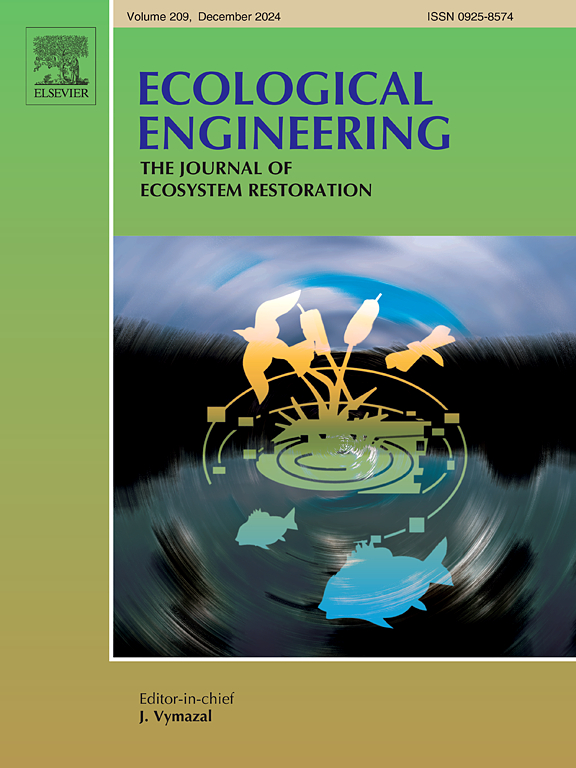改善荒漠化分级和土地利用的精细整合,监测和修复沙漠边缘的生态
IF 4.1
2区 环境科学与生态学
Q1 ECOLOGY
引用次数: 0
摘要
荒漠化仍然是一个严重的问题,特别是在生态脆弱和容易发生荒漠化的沙漠边缘地区。本文创新性地建立了更精确的荒漠化严重程度分级模型,并分析了不同土地覆被类型的荒漠化状况,以改进现有的治理措施。以辽宁省为例,构建了基于特征空间的改进分级模型,并采用随机森林模型对沙漠化土地覆盖类型进行分类。将这些结果与荒漠化严重程度相结合,提供了精细尺度的信息。基于MSAVI-DI(修正土壤调整植被指数-干旱指数)特征空间投影距离模型的沙漠化严重程度动态监测结果显示,2019年沙漠化总面积为4930.28 km2。近10年来,沙漠化面积减少了373.71 km2。精细尺度信息分析表明,沙漠化治理和生态恢复应优先考虑景观破碎化程度较高的地区。管理不善和被遗弃的农田容易进一步沙漠化,这突出了有针对性的管理努力的重要性。总体而言,本研究构建了荒漠边缘沙漠化严重程度分级模型。同时,还获得了包括沙漠化严重程度和土地覆盖类型在内的沙漠化精细尺度信息。这为今后的沙漠化恢复提供了更准确的依据。本文章由计算机程序翻译,如有差异,请以英文原文为准。
Improved desertification grading and fine-scale integration of land use and severity for monitoring and ecological restoration at desert margins
Desertification remains a critical issue, particularly in desert fringe areas that are ecologically fragile and prone to desertification. This paper innovatively develops a more accurate desertification severity grading model for these areas and analyzes the desertification situation across different land cover types to improve existing control measures. An improved grading model based on feature space was constructed for Liaoning Province, and a random forest model was used to classify desertified land cover types. Combining these results with desertification severity provided fine-scale information. The results of the dynamic monitoring of desertification severity based on the projection distance model in MSAVI-DI (Modified Soil Adjusted Vegetation Index- Drought Index) feature space showed that the total area of desertification in the 2019 is 4930.28 km2. Over the past decade, the total desertified area has decreased by 373.71 km2. The fine-scale information analysis indicates that desertification management and ecological restoration should prioritize areas with more fragmented landscapes. Poorly managed and abandoned croplands are prone to further desertification, underscoring the importance of targeted management efforts. Overall, the study constructed a grading model of desertification severity for desert margins. At the same time, fine-scale information on desertification containing the severity of desertification and land cover type was obtained. This provides a more accurate basis for future desertification restoration.
求助全文
通过发布文献求助,成功后即可免费获取论文全文。
去求助
来源期刊

Ecological Engineering
环境科学-工程:环境
CiteScore
8.00
自引率
5.30%
发文量
293
审稿时长
57 days
期刊介绍:
Ecological engineering has been defined as the design of ecosystems for the mutual benefit of humans and nature. The journal is meant for ecologists who, because of their research interests or occupation, are involved in designing, monitoring, or restoring ecosystems, and can serve as a bridge between ecologists and engineers.
Specific topics covered in the journal include: habitat reconstruction; ecotechnology; synthetic ecology; bioengineering; restoration ecology; ecology conservation; ecosystem rehabilitation; stream and river restoration; reclamation ecology; non-renewable resource conservation. Descriptions of specific applications of ecological engineering are acceptable only when situated within context of adding novelty to current research and emphasizing ecosystem restoration. We do not accept purely descriptive reports on ecosystem structures (such as vegetation surveys), purely physical assessment of materials that can be used for ecological restoration, small-model studies carried out in the laboratory or greenhouse with artificial (waste)water or crop studies, or case studies on conventional wastewater treatment and eutrophication that do not offer an ecosystem restoration approach within the paper.
 求助内容:
求助内容: 应助结果提醒方式:
应助结果提醒方式:


